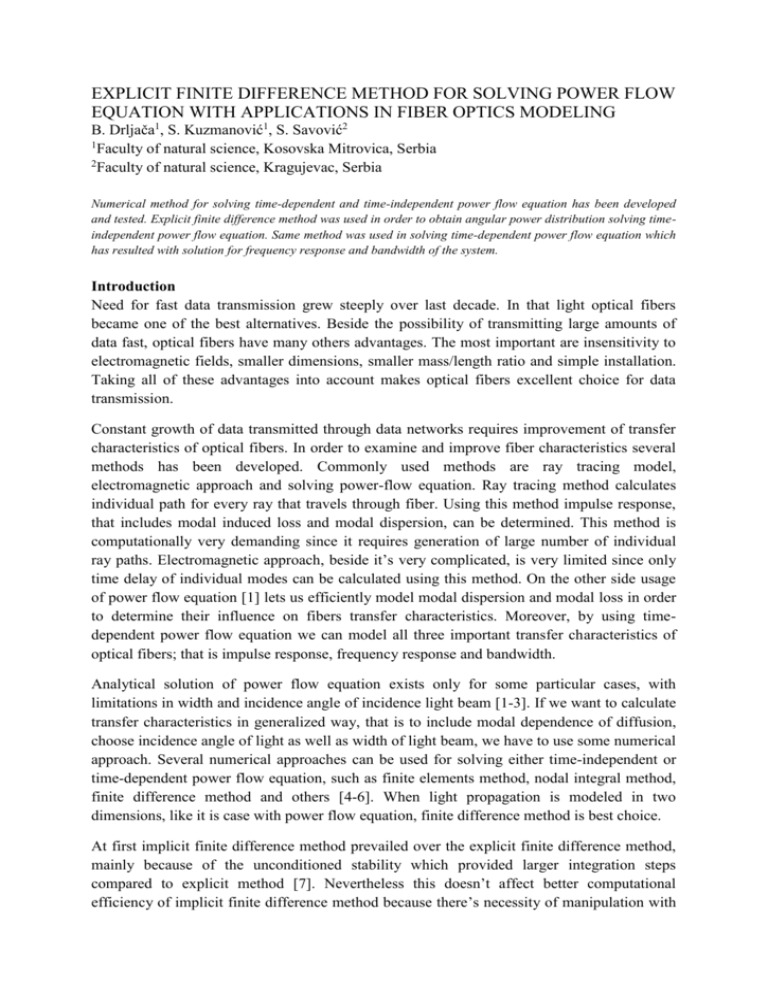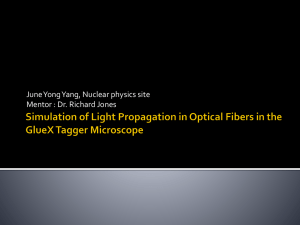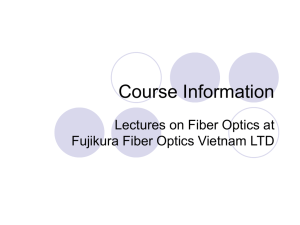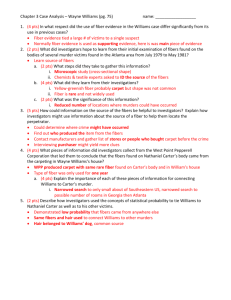NUMERICAL METHOD FOR SOLVING POWER FLOW
advertisement

EXPLICIT FINITE DIFFERENCE METHOD FOR SOLVING POWER FLOW EQUATION WITH APPLICATIONS IN FIBER OPTICS MODELING B. Drljača1, S. Kuzmanović1, S. Savović2 1 Faculty of natural science, Kosovska Mitrovica, Serbia 2 Faculty of natural science, Kragujevac, Serbia Numerical method for solving time-dependent and time-independent power flow equation has been developed and tested. Explicit finite difference method was used in order to obtain angular power distribution solving timeindependent power flow equation. Same method was used in solving time-dependent power flow equation which has resulted with solution for frequency response and bandwidth of the system. Introduction Need for fast data transmission grew steeply over last decade. In that light optical fibers became one of the best alternatives. Beside the possibility of transmitting large amounts of data fast, optical fibers have many others advantages. The most important are insensitivity to electromagnetic fields, smaller dimensions, smaller mass/length ratio and simple installation. Taking all of these advantages into account makes optical fibers excellent choice for data transmission. Constant growth of data transmitted through data networks requires improvement of transfer characteristics of optical fibers. In order to examine and improve fiber characteristics several methods has been developed. Commonly used methods are ray tracing model, electromagnetic approach and solving power-flow equation. Ray tracing method calculates individual path for every ray that travels through fiber. Using this method impulse response, that includes modal induced loss and modal dispersion, can be determined. This method is computationally very demanding since it requires generation of large number of individual ray paths. Electromagnetic approach, beside it’s very complicated, is very limited since only time delay of individual modes can be calculated using this method. On the other side usage of power flow equation [1] lets us efficiently model modal dispersion and modal loss in order to determine their influence on fibers transfer characteristics. Moreover, by using timedependent power flow equation we can model all three important transfer characteristics of optical fibers; that is impulse response, frequency response and bandwidth. Analytical solution of power flow equation exists only for some particular cases, with limitations in width and incidence angle of incidence light beam [1-3]. If we want to calculate transfer characteristics in generalized way, that is to include modal dependence of diffusion, choose incidence angle of light as well as width of light beam, we have to use some numerical approach. Several numerical approaches can be used for solving either time-independent or time-dependent power flow equation, such as finite elements method, nodal integral method, finite difference method and others [4-6]. When light propagation is modeled in two dimensions, like it is case with power flow equation, finite difference method is best choice. At first implicit finite difference method prevailed over the explicit finite difference method, mainly because of the unconditioned stability which provided larger integration steps compared to explicit method [7]. Nevertheless this doesn’t affect better computational efficiency of implicit finite difference method because there’s necessity of manipulation with large matrices in every computational step. When we take this into account we can say that, although explicit finite difference method is more sensitive in the aspect of scheme stability, it’s simpler and more efficient than implicit finite difference method. That is why we have chosen to use explicit finite difference method for solving power flow equation. Explicit finite difference method First we will show how we employed explicit finite difference method in order to solve timeindependent power flow equation. Later same method will be employed in solving timedependent power flow equation. Examples for both equations are also shown. Time-independent power flow equation can be written as [1]: P( , z ) D( ) ( ) P( , z ) z P( , z ) (1) where P ( , z ) is power distribution over angle and space; ( ) is mode-dependent attenuation; and D( ) is the mode-dependent coupling coefficient. Mode-dependent attenuation can be written in the form ()= 0 A 2 ... , where 0 is loss common to all modes. It can be accounted for by multiplying the end-solution by e 0 z [7, 8], so equation (1) can be rewritten in form: P( , z ) D P( , z ) 2 P( , z ) A 2 P( , z ) D z 2 (2) The tacit assumption that coupling coefficient D( ) is constant has been routinely made when mode coupling by the power flow equation has been investigated in the absence of reliable estimates of other terms in the expansion series of D( ). Boundary conditions for equation (1) are: P(c , z ) 0; D P 0 0 (3) where c is critical angle of the fiber. First condition means that modes that propagate at angles c don’t transfer power. Second condition implies that mode coupling is limited only to modes that propagate at angles 0. Using central difference scheme for derivatives (P( , z)) and ( 2 P( , z )) 2 [4, 9]: Pi 1, j Pi 1, j P ( , z ) O( ) 2 2 i , j (4) Pi 1, j 2 Pi , j Pi 1, j P 2 ( , z ) O( ) 2 2 2 ( ) i , j (5) and forward difference scheme for derivative P( , z) z : Pi , j 1 Pi , j P ( , z ) O(z ) z z i , j (6) equation (2) can be written in form [10]: zD zD zD zD 2zD Pi , j 1 zAi2 Pi , j P Pi 1, j 1 2 2 2 i 1, j 2 2 i i (7) where subscripts i and j refer to discrete steps i z for angle and length z, respectively. Boundary conditions (3) now become: PN,ј = 0, P0,ј = P1,j (8) where N c is grid dimension in direction . In order to overcome singularity problem in points 0 we use relation [6]: 1 0 lim 2 P P 2 2 0 (9) The input condition must also be expressed in difference form. For example, the plane-wave launch distribution, which is in the form of a Dirac delta function, can be expressed as: P( , 0) 1, P( , 0) 0, 0 za 0 za (10) with 0 < < c , where 0 is the angle of the launch to the fiber axis. To facilitate the comparison of results, we applied our method to (Mitsubishi Rayon) Eska Premier SI POF fiber, because this fiber was used in the experiment of Zubia et al. [11]. This fiber has a core diameter of d = 0.98 mm, a refractive index of the core of n 1 = 1.492, a theoretical numerical aperture (N.A.) of 0.5, and a critical angle c =19.6° (measured inside the fiber; i.e., c = 30° measured in air). Values of D = 7.5 X 10-4 rad2/m and A = 1.37 (rad2m)-1 have been reported for this fiber [11, 12]. Our numerical solution of the power flow equation gives the evolution of the normalized output power distribution with fiber length z as z is increased incrementally from zero until the steady state distribution is achieved. At each step a new distribution curve is obtained with a decreased maximum and increased width. The situation is shown in Fig. 1 for four such selected z values, each with four different input angles 0 = 0, 5.5, 16, 29° (measured in air). In keeping with what has become a customary way of presenting such distributions [12], they are shown in Fig. 1 with their maxima normalized. Attention is drawn to the shift that occurs in the corresponding distribution curves while z is moved throughout the parts of Fig. 1. In the calculations we used step lengths = 0.05° and z = 0.0002 m to achieve stability in our finite-difference scheme [4, 6]. Figure 1. Numerically determined normalized output angular power distribution for a plane wave launched with input angles 0 = 0° (solid curves), 5.5° (dashed curves), 16° (dotted curves), and 29° (dashed-dotted curves) at various locations along the SI POF: z = 3 m, z = 10 m, z = 17.6 m, and z = 48 m. Since our method can accommodate any initial condition we were able to test it with known analytical solution for same fiber. Without going into limitations of analytical method we will present obtained results for fiber mentioned above [10] and compare it with our numerical results. Results obtained by numerical solution are presented in Fig. 1, while analytical solutions are presented in Fig. 2. Differences appear primarily for the highest modes and in the tails of the distribution curves. In our view, the tails in the analytical solution of Fig. 2 incorrectly imply that power is transmitted even at angles above the critical angle of 30° in air, as indicated by the nonzero intensity at +30° and -30° in Fig. 2. This difference between Figs. 1 and 2 is more pronounced for larger launch angles and is attributed to the influence of the boundary condition at c [P( c , z) = 0], which the analytical solution ignores. Figure 2. Analytically determined normalized output angular power distribution for a plane wave launched with input angles 0 = 0° (solid curves), 5.5° (dashed curves), 16° (dotted curves), and 29° (dashed-dotted curves) at several locations along the SI POF: z = 3 m, z = 10 m, z = 11.6 m, and z = 48 m. Thus our numerical solution of the power flow equation, which takes into account the boundary conditions at both 0 and c , is more accurate. By solving time-independent power flow equation we can determine coupling length of optical fibers. If we want to calculate transfer characteristics of optical fibers we have to employ Gloge’s time-dependent power flow equation, which can be written in form [2]: P ( , z, t ) z t P ( , z, t ) z t A 2 P ( , z , t ) D P ( , z , t ) (11) The derivative t z can be obtained using the group velocity of a mode with characteristic angle , which is dz dt c n(1 2 2) [2]. Neglecting the delay n c common to all modes, it follows [8]: P ( , z, t ) z A 2 P ( , z, t ) n 2c 2 P ( , z, t ) t D ( P ( , z, t ) ) (12) By applying the Fourier transform, p ( , z , ) P( , z, t )e jt dt , the time-dependent equation (12) transforms into (13): p ( , z, ) z n 2 D p ( , z, ) 2 p ( , z, ) 2 A j p ( , z, ) D( ) (13) 2c 2 where 2 f is the angular frequency. The boundary conditions are same as for the timeindependent power flow equation (3). It is apparent that p ( , z , ) is complex. We can therefore separate p ( , z , ) into its real and imaginary parts, p=pr+jpi. Equation (13) can now be rewritten as the following simultaneous differential equations: p r z p i z A 2 p r A p 2 i D p r D p i D D 2 pr 2 2 pi 2 n 2c n 2c 2 pi p 2 (14) r Once pr and pi are obtained by solving equations (14), frequency response at z can be easily calculated [13]. After separating the power flow equation (13) into two simultaneous equations (14), we solved the latter (14) by explicit finite difference method. Using central difference scheme (4) and (5) for derivatives p( , z, ) / and p( , z, ) / 2 2 and forward difference scheme (6) for derivative P( , z, ) z equations (14) can be written in the form [4, 6, 8]: zD zD r pk 1,l 2 2 k pkr ,l 1 1 2zD 2 zA k2 pkr ,l + (15) zD zD r nz 2 i + p k pk ,l k 1, l 2 2 2 c k and zD zD i pk 1,l 2 2 k pki ,l 1 1 2zD 2 zD zD i nz 2 r + p k pk ,l 2 k 1,l 2 2 c k Boundary conditions (3) now become: zA k2 pki ,l (16) pNr ,l 0, pNi ,l 0 and p0,r l p1,r l , p0,i l p1,i l (17) where N=θc /Δθ is the grid size in the direction. In order to prevent the problem of singularity at grid points 0 , the relation (9) is used [6]. In order to test our results we have used our method and obtained frequency response and bandwidth of the same SI POF that was investigated by Mateo et al. [13]. The fiber is HFBRRUS100 (HFBR) from Agilent, with numerical aperture NA=0.47 (corresponding to the inner critical angle of c =18.5o) and 0.22 dB/m of nominal attenuation. Values for A and D that we have used are A=0.7539 (rad2 m)-1 and D4.3110-4 rad2/m [14]. Figure 3. Left - Comparison of numerical results, measurements by Mateo et al. [13] and analytical solution [15] for frequency response of the HFBR fiber. Right - Comparison of numerical results, measurements by Mateo et al. [13] and analytical solution [15] for the functional dependence of the HFBR fiber bandwidth on its length. In Fig. 3 (left), frequency response of the HFBR fiber is shown for the fiber lengths of 15, 50 and 100 m, and are compared with experimental results obtained by Mateo et al. [13] as well as with the analytical solution [15]. In figure 3 (right) our numerical results for the bandwidth for the HFBR fiber is compared to Mateo et. al’s [13] experimental measurements and to our recent analytical solution [15, 16]. Conclusion We have shown full numerical solution of power flow equation obtained by explicit finite difference method. Our method overcomes problems that are present in analytical solution of power flow equation. We were able to model, both, modal coupling process and modal loss. Firstly we solved time-independent power flow equation for one fiber and compared it to analytical solution, where we can clearly see advantage of our method. Later we have solved time-dependent power flow equation, whose solving is necessary if transfer characteristics of fiber are to be known. Solution has been compared to, both, experimental and analytical solution for sampled fiber. From the results above, we can conclude that our solution is stable, general and more accurate than analytical solution. Acknowledgments The work described in this paper was supported by grant from Serbian Ministry of Education and Science [Project No. 171011]. Literature [1] Gloge D. Optical power flow in multimode fibers. Bell Syst. Tech. J. Vol. 51. 1972. P. 1767–1783. [2] Gloge D. Impulse Response of Clad Optical Multimode Fibers. AT&T Tech. J. Vol. 52. 1973. P. 801–816. [3] Drljaca B, Savovic S, Djordjevich A. Calculation of frequency response in step-index plastic optical fibers using the time-dependent power flow equation. Opt. Laser Eng. Vol. 49. 2011. P. 618–622. [4] Anderson J. D. Computational Fluid Dynamics. McGraw-Hill. New York. 1995. [5] Caldwell J, Savović S, Kwan Y. Y. Nodal integral and finite difference solution of onedimensional Stefan problem. J. Heat Transf.-Trans. ASME 125, 2003. P. 523–527. [6] Djordjevich A, Savović S. Investigation of mode coupling in step index plastic optical fibers using the power flow equation. IEEE Photon. Technol. Lett. 12, 2000. P. 1489–1491. [7] Rousseau M, J eunhommeL. Numerical solution of the coupled-power equation in step index optical fibers. IEEE Trans. Microwave Theory Tech. 25, 1977. P. 577–585. [8] Savović S, Djordjevich A. Influence of numerical aperture on mode coupling in step index plastic optical fibers. Appl. Opt. Vol. 43. 2004. P. 5542–5546. [9] Savović S, Djordjevich A. Influence of initial dopant distribution in fiber core on refractive index distribution of thermally expanded core fibers. Opt. Mat. Vol. 30. 2008. P. 1427–1431. [10] Djordjevich A, Savović S. Numerical solution of the power flow equation in step index plastic optical fibers. J. Opt. Soc. Am. B Vol. 21, 2004. P. 1437–1442. [13] Toshiki P. T. Shoji Y. Numerical solution of power flow in multimode W-type optical fibers. App. Opt. Vol. 19. No. 10. 1980. P. 1647-1652. [11] Zubia J, Durana G, Aldabaldetreku G, Arrue J, Losada M. A, Lopez-Higuera M. New method to calculate mode conversion coefficients in SI multimode optical fibers. J. Lightwave Technol. Vol. 21, 2003. P. 116-181. [12] Dugas J, Maurel G. Mode-coupling processes in poly-(methyl methacrylate) -core optical fibers. Appl. Opt. Vol. 31. 1992. P. 5069-5019. [13] Mateo J, Losada M.A, Zubía J. Frequency response in step index plastic optical fibers obtained from the generalized power flow equation. Opt. Express Vol. 17. 2009. P. 2850– 2860. [14] Drljaca B, Djordjevich A, Savović S. Frequency response in step-index plastic optical fibers obtained by numerical solution of the time-dependent power flow equation. Opt. Las. Tec. Vol. 44. 2012. P. 1808-1812. [15] Drljaca B, Savović S, Djordjevich A. Calculation of the frequency response and bandwidth in step-index plastic optical fibres using the time-dependent power flow equation. Phy. Scr. T. 149. 2012. [16] Drljaca B, Savović S, Djordjevich A. Calculation of the frequency response of stepindex plastic optical fibers using the time-dependent power flow equation. Opt. Lasers Engg. Vol. 49, 2011. P. 855–858.






